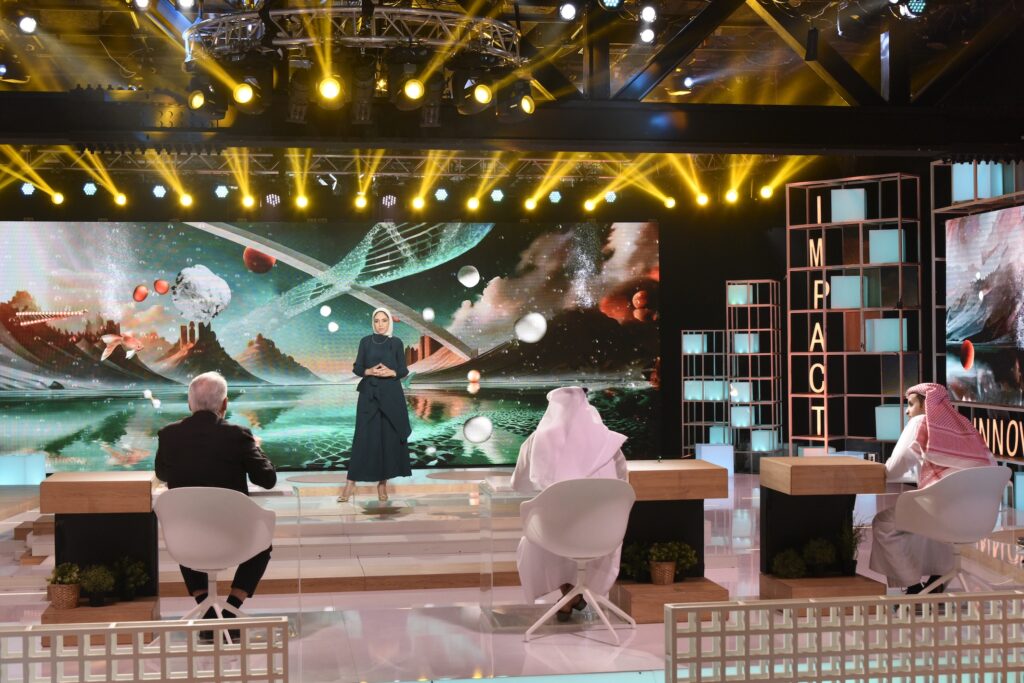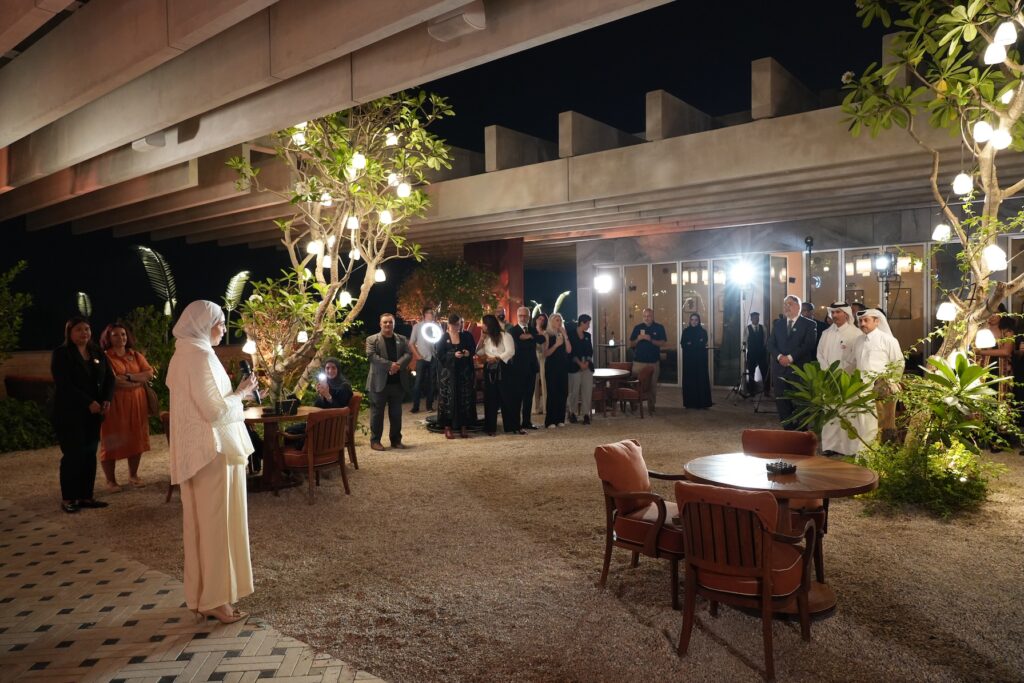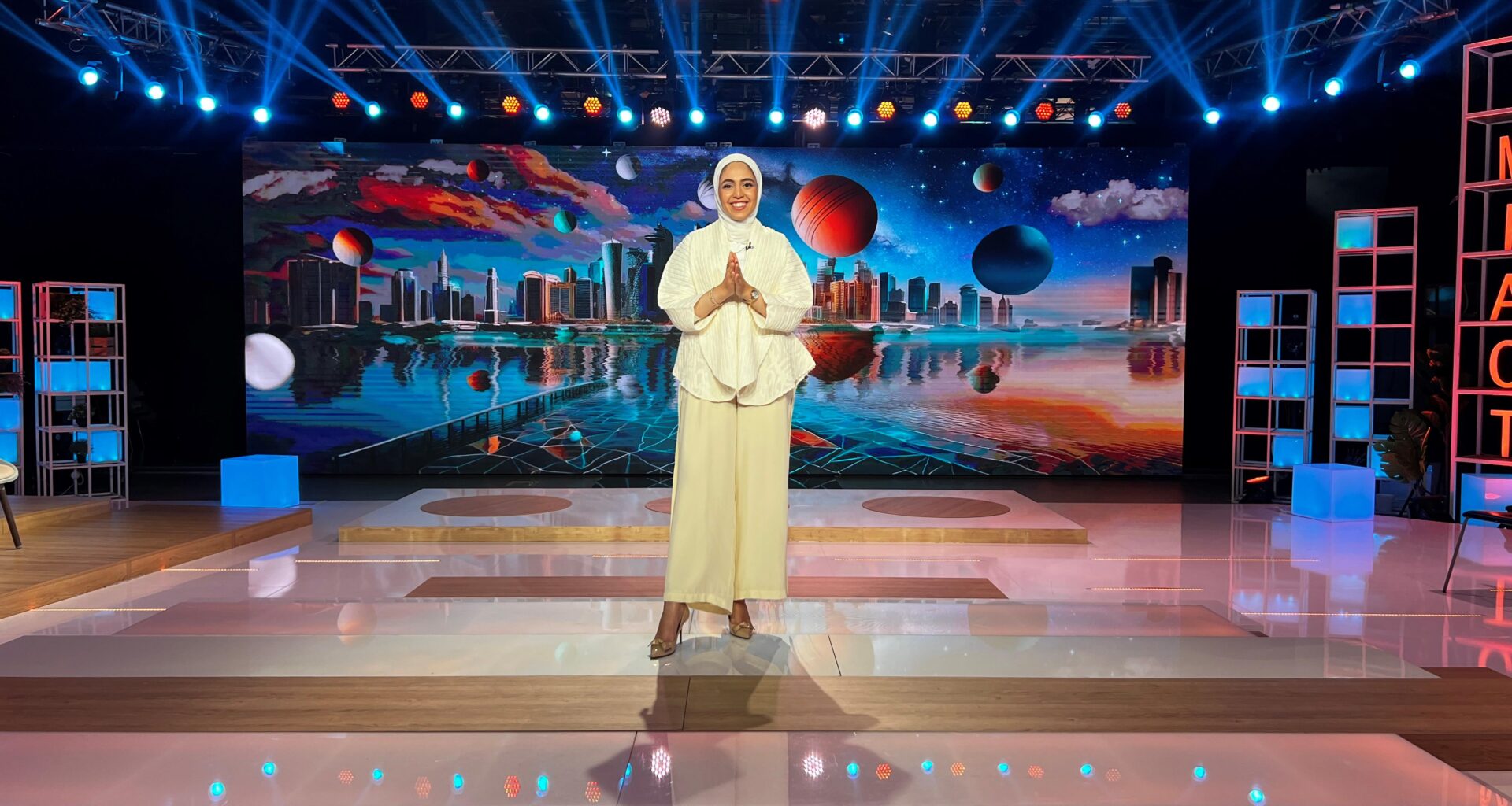Nada Elkharashi, a VCUarts Qatar BFA in Interior Design and MFA in Design graduate, emerged as a finalist in the 16th edition of Stars of Science – a remarkable feat given that she was also the first VCUarts Qatar graduate to participate in the competition.
She pitched a project titled ‘BioVolt’ to the jury. BioVolt generates electricity from air humidity using bacterial nanowires. This self-powering, wearable biomaterial holds the promise of providing sustainable energy to underserved communities.
BioVolt evolved from ‘Electric Skin’, a project that Elkharashi, has been working on with researchers Catherine Euale (Venezuelan-Italian, based in Mexico), Sequoia Fischer (US) and Paige Perillat-Piratoine (France) since 2021.
In this conversation, Elkharashi, talks about her experience – and emotions – on participating, making it to the finale, and then placing third on the popular Arabic edutainment show.

From walking into VCUarts Qatar as a foundation year student to reaching the top three on Stars of Science, you've made quite the journey. Has it sunk in yet – that you've achieved what no other VCUarts Qatar graduate has achieved: reaching the grand finale of one of the region's most popular science and innovation shows?
Oh my, just reading that question is making me tear up! No, it has not sunk in at all—not even a little! Maybe because I don’t really see this as an “achievement” in the typical sense. It’s more like I’ve always been following what I enjoy doing. I’ve never approached my major or my work as a job, but rather as an expression of who I am and who I want to be, and what I want to gain from life.
So even now, having made it to the top three of Stars of Science, it feels like I’m just following the flow of my life and this different channel that brought me here, following my curiosity, challenging myself, and learning along the way. I think that’s why it hasn’t fully hit me yet. For me, it’s never been about “achieving” something. It’s about سعي(seeking/pursuit), that’s what I call it in Arabic. It’s this constant pursuit of what feels meaningful, and that’s what drives me.
You prefer to be known as an interdisciplinary designer as you don't like confining yourself to labels or specializations. How did that mindset develop and mature?
To be honest, it all goes back to my Interior Design undergraduate studies in 2014, where I felt that what interested me in design was the fact that I was merging science, culture, people, and behavior into my interior design projects. For instance, I remember clearly that for my BFA thesis, all I wanted to do was respond to the fact that economy seats weren’t a good 'fit' for all people and for long flights, and all I wanted to do was design a solution. Back then, the Interior Design department refused my proposal as it didn't fit the scope of the department. This made me lean towards a more interdisciplinary approach for my MFA studies.
It was during my studies at VCUarts Qatar that I slowly discovered who I really am and realized that it’s fine not to specialize in one specific area. I have many different interests because I am interested in behavior, people, science, technology, and culture. Even the act of observation holds endless possibilities. I admit that it wasn't easy to reach the point where I am now, where I’m comfortable to be known as an interdisciplinary designer.

Let’s talk about your collaboration that led to Electric Skin and then BioVolt – how did that materialize?
After my MFA, I had this “me” session, just me, sitting in a café in Alexandria, Egypt, drawing out four pillars that really interested me. One of those pillars was bio-design, and from there, I started looking up workshops and competitions online to dive deeper into them. In 2021, I attended an online Biodesign X Google competition. That’s where I met my future co-founders of Electric Skin – Catherine Euale, Sequoia Fischer and Paige Perillat-Piratoine. None of us had worked together before, and I hadn’t even met them in person! But I thought, “What could go wrong?” The fact that it was remote actually made it easier for me since the social fear of face-to-face interactions wasn’t there.
We all just clicked. For me, it wasn’t just about the science; I was drawn to how I could bring in this emotional connection to electronics. For example, how we form attachments to our phones and how such equipments ‘age’ with time, just like we do. That mindset – of accepting the unexpected and the new, new people and new perspectives, has helped me shape who I am as a designer and pursue the projects I’m passionate about.
How steep was that learning curve, given that you’re not from a pure science background?
To be honest, when I first got involved in the Electric Skin project, I didn’t understand a single word of the science behind it. But I told myself, "It’s okay; I’ll learn it.” So, I just dove in, taught myself what I needed to know, and trusted that I’d pick up the pieces along the way.
I had similar experiences during the Stars of Science competition, where I didn’t just have to understand the science; I had to sit with mentors, doctors, specialists, and researchers, understand their opinions and instructions, and apply them.
In fact, in the beginning, I used to be apologetic to the Stars of Science team. I’d say, “I’m sorry, but this is not my specialty. Perhaps we can arrange a meeting with Sequoia (one of the four researchers in the project).” However, I quickly realized that I didn’t have the luxury of asking for interpretations or explanations at every stage, as the project was evolving quite quickly. So, I just had to adjust, take notes, and force myself to understand until I finally did. Of course, knowing that I had my teammates, Catherine, Sequoia, and Paige, by my side helped.

When did you first think of applying for Stars of Science?
Honestly, I didn’t even know the show existed! It all started when I visited Dubai to present the Electric Skin project at COP 28, at the ‘Prototype for Humanity’ session. While I was there, I met a Stars of Science alumnus, and he started casually talking about the benefits of the show.
At first, I wasn’t excited. But the alumnus I met in Dubai had sent a video of the Electric Skin project to Stars of Science, and apparently, they liked the project. That’s when I gave it some thought. I consulted a few of my trusted friends. I talked to my Electric Skin co-researchers. I think it’s worth mentioning that applying to the competition was a decision we all took together. We sat down as a team and looked at what the show offered, wondering if we even fit the criteria. At the time, we thought our project was still a bit far from being a commercial product, which seemed to be the goal of the show. But we decided to take the opportunity and go with the flow as long as it lasted. We literally submitted the application at the last minute. In fact, it was Paige who filled out the application with my name because I was too busy with ‘Prototype for Humanity’.
I also talked to Dr. Khaled. And, of course, I prayed a lot. I told myself to just be present at the casting and not overthink it. My team’s aim was straightforward and modest – my participation was to share the project on a public stage. I wasn’t thinking about moving forward in the competition at all; it was more about showing what we were working on.
Your project BioVolt evolved from your research titled Electric Skin. Once you were accepted into Stars of Science, how did the research progress?
Our mindset changed when I pitched our project to the judges, and they appreciated it – that was a huge turning point for us all. Catherine even traveled to the States to meet with Sequoia, collect the proteins necessary to advance the research, and then travel to Qatar. Together, we worked through an almost impossible amount of work in such a short time.
Before Stars of Science, our technology could generate 0.7 volts from a tiny 0.5 by 0.5 cm piece. During the show, we managed to scale that up to generate 8 volts! And not only that—we were able to store the energy and even operate a device with it. It felt like a miracle, honestly. And a huge leap in terms of progress.
And your emotions?
There were moments when I would suddenly feel the weight of representing the whole team. When Catherine joined me in Qatar – after we advanced to the top 5 – we shared that workload. That helped a lot. But right after they announced our qualification to the top four, she had to leave. That’s when things really shifted for me. It wasn’t just about the technology, the design or the product anymore; it became about how we fit into the market. This brought out a lot of raw emotions in me, as now I had to juggle technology and design with strategy and business. It was a long and tiring process, but it was worth it.
Every day was a learning experience, even though I was juggling my other design projects simultaneously. For instance, my projects were part of the Design Doha Biennale, and the Korean Gwangju Biennale held this year. It wasn’t easy, but it was enjoyable. I was juggling different hats and living different lives, but I loved it.
Coming in third as opposed to being top three. There’s a difference in perspective here. Did you experience that?
One is always hopeful of winning, and if I had been told back then that I would leave with third place, I would have been so happy with everything Catherine and I managed to accomplish for Electric Skin in such a short time.
Until the voting started, it was all about the project, the techniques and attaining a commercially viable product. But when the voting campaign started, it became more personal. It wasn’t just about Electric Skin and my co-researchers anymore—it was about me, representing VCUarts Qatar, representing my home country, Qatar, and representing where I’m originally from, Egypt. So, when I first heard the news of making it to the third place, I felt down. I felt like I was carrying the weight of so many people.
But now, a few days after the finale, I feel only gratitude for growth—growth for our project, our team, and me.

On the show you were mentored by your former professor at VCUarts Qatar, Dr. Khaled. What was that like?
It was surreal, honestly! Dr. Khaled taught me a class on ‘energy’ back in 2014, and now in 2024, exactly 10 years apart, here we were literally creating energy. It’s wild how life comes full circle. I never imagined I’d be working with him again, especially in this way.
Having him as my mentor during Stars of Science felt comforting. Seeing someone familiar brought a sense of calm and reassurance. I could tell from the way he looked at me that he was proud, and that meant so much. When I heard his report on TV, it made me so happy to hear him talk about Electric Skin’s achievements from such an academic perspective. It felt like we were actually getting a step closer to making real change.
You studied a BFA and then an MFA at VCUarts Qatar. How did that influence your course of life?
Both degrees shaped me in different ways, but my MFA had a direct impact on Electric Skin. The independent course I took during my MFA program was really what opened things up for me. It gave me the freedom to dive into something new: bio-design, on my own terms. If it wasn’t for that space to explore bio-design independently, I don’t think I would’ve had the curiosity to go searching for bio-design competitions, and that’s how I met the rest of the Electric Skin team. That freedom to learn in an academic setting was key.
And, of course, the hands-on fabrication skills I learned at VCUarts Qatar were super helpful when it came to the BioVolt project. We faced a setback during the project development phase of Stars of Science when a printer we needed broke down. We had to do everything by hand. I ended up silk-screening electrodes, laser-cutting molds, soldering—all the skills I’d picked up at university. So, it was a mix of creative freedom and technical skills that I picked up at VCUarts Qatar that really helped me push the project forward.
Do you have any thoughts you’d like to share with students who aspire to walk in your footsteps?
Looking back at my journey, I realize that feeling a bit lost or unsure can be helpful. If I had known exactly what I wanted to do, I wouldn’t have explored or been curious. So, my advice would be: don’t be afraid of the unknown or of feeling undirected. It’s okay, and sometimes it’s what leads you to discover new things.
Also, be patient with the process. I still remind myself of that all the time. Be kind and patient with yourself too.
And one more thing: try to blend different disciplines. Connect different fields and ideas because that’s where some of the most interesting and unexpected work happens. It’s not always about staying in one lane; sometimes, it’s about seeing what happens when you combine different ones.
Words by Mary Joseph
This series is part of an editorial partnership brought to you by VCUarts Qatar and Khaleejesque.







